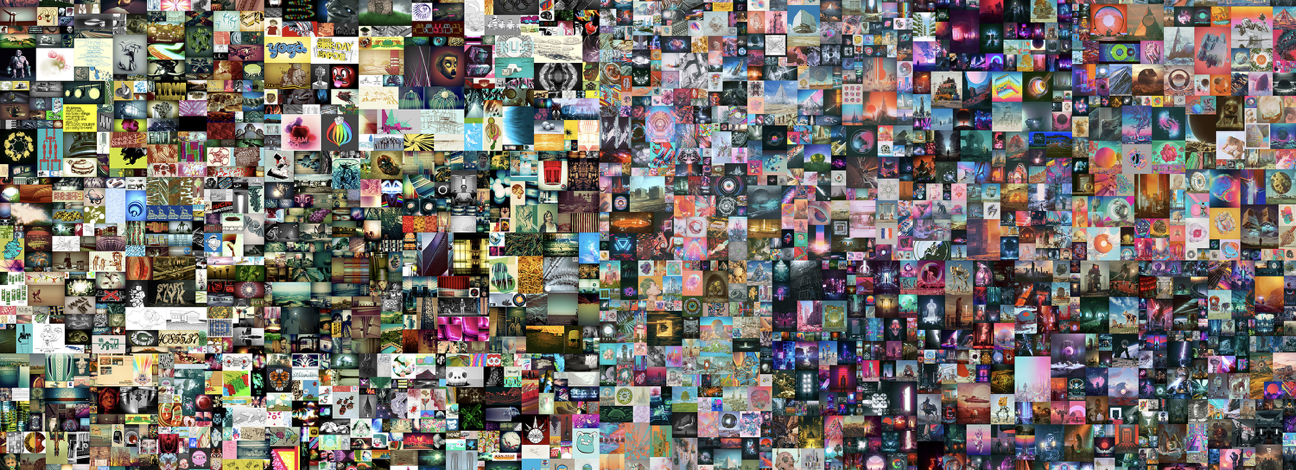Six questions about NFTs
A digital image sold for $69 million using “non-fungible token” technology. What does this all mean?
 A section of Beeple’s “Everydays: the First 5000 Days.” Who owns this image? Maybe I do: it’s stored among my website files. Maybe you do now: it’s on your screen, after all. What does ownership even mean here? (Regardless, I believe display at this resolution in this context is covered by fair use.) Screenshot credit: Christie’s
A section of Beeple’s “Everydays: the First 5000 Days.” Who owns this image? Maybe I do: it’s stored among my website files. Maybe you do now: it’s on your screen, after all. What does ownership even mean here? (Regardless, I believe display at this resolution in this context is covered by fair use.) Screenshot credit: Christie’s
These are questions I have that have not yet been answered by news coverage, which has generally sidestepped the most interesting technical, legal and social issues raised.
Just because I’ve listed a question here doesn’t mean there isn’t an easy answer online somewhere. (Ethereum RFCs, from what I can tell, answer the technical questions. But most of these are not purely technical questions.)
-
What does it really mean to own an NFT? As I understand it ownership usually means that a court will compel possession of an object or of economic rents flowing from an intangible. There is nothing here to be possessed. It does seem that there are some display rights attached to the Beeple NFT. So is this just a fancy way of establishing a transferrable license to those rights? If an NFT established no legal rights at all, but merely created the technical capability to transact it on the blockchain, is it ownership in any sense?
-
Can an artist create and sell another NFT relating to the same artwork within the same NFT implementation? Could they claim that this new NFT, and not the old one, denoted ownership? What technical measure prevents this—is it simply priority on the blockchain? Is there some legal undertaking to prevent this? Is this fraud, legally speaking?
-
Can an artist create and sell another NFT relating to the same artwork on another NFT implementation on the same blockchain or on another blockchain?
-
What if someone pretending to be the artist creates and sells an NFT for an artwork? Identity must be established by some real-world authority. Do NFTs then necessarily require an “identity sponsor” of some sort? Can artists that somehow already have an established blockchain identity self-sponsor? Should all digital artists now immediately create an NFT fo any new work simultaneous with its release to guard against this risk?
-
Can you transfer an NFT from one NFT implementation to another on the same blockchain or from one blockchain to another? If you can, is there a single uncontested way to do that? If there isn’t, doesn’t that refute nonfungibility?
-
If Christie’s auctions an NFT for an digital artwork on Ethereum and the NFT implementation or Ethereum itself subsequently fails,1 does Christie’s now become, by default, the authority on digital ownership of that artwork? (Christies has, after all, been around for over 250 years and Ethereum a bit over 5: it would not be unreasonable to expect the former to outlast the latter.) If so, what was the point of the blockchain? Christie’s may as well have tracked ownership internally. But if not, does the NFT simply lose all its value?
-
Blockchain systems themselves are pretty well-tested and won’t necessarily fail, so read “fail” here as either
- the smart contract supporting the NFT has a flaw in it, allowing a virtual state to occur that is considered illegitimate or illegal in the real world; or
- what remains of the Ethereum network is widely considered to be illegitimate for some reason.
Add comment
Comments are moderated and will not appear immediately.